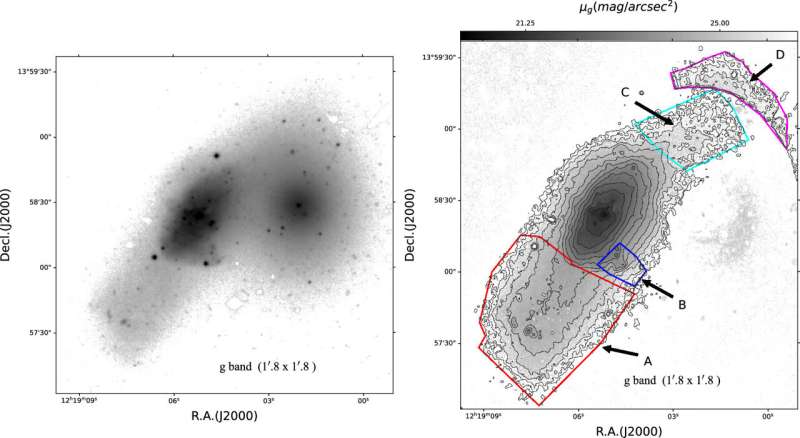This article has been reviewed according to Science X's editorial process and policies. Editors have highlighted the following attributes while ensuring the content's credibility:
fact-checked
peer-reviewed publication
trusted source
proofread
Study unveils impact of mergers on star formation in dwarf galaxies

Interactions between galaxies, including mergers and tidal interactions, have been extensively studied. It has been established that mergers between massive galaxies can alter galaxy morphologies, enhance star formation, and even trigger starbursts.
Due to the weak gravitational potential wells of dwarf galaxies, their star formation distribution and density are more easily affected by mergers and stellar negative feedback. However, limitations in the observation have resulted in less research on merging dwarf galaxies.
Utilizing data from the Next Generation Virgo Cluster Survey project, Zhang Lanyue from Yunnan Observatories of the Chinese Academy of Sciences, and her collaborators, analyzed the tidal tails of the dwarf galaxy VCC322 produced by merger. The study is published in The Astrophysical Journal.
Researchers determined the metallicity and stellar age of the tidal tails based on color and single stellar population model fitting. Isophotal fitting revealed isophotal twisting inside a neighboring dwarf elliptical galaxy VCC319, suggesting that this galaxy was also affected by the merger.
Based on spectral data fitting of stellar population information and star formation rates, researchers found that VCC322 had experienced recent star formation, although at a low star formation rate.
By comparing VCC322 with other star-forming dwarf galaxies in the Virgo cluster and with merging dwarf galaxy systems in terms of neutral hydrogen mass and star formation rates, they identified a suppression of its star formation.
In addition, by comparing the emission line flux ratios obtained from spectral data with shock models, researchers suggested that shocks generated by mergers/interactions are present within VCC322, heating the gas and thus inhibiting star formation.
More information: Lan-Yue Zhang et al, A Study of the Merging Dwarf Galaxy VCC322, The Astrophysical Journal (2024). DOI: 10.3847/1538-4357/ad2f2d
Journal information: Astrophysical Journal
Provided by Chinese Academy of Sciences




















